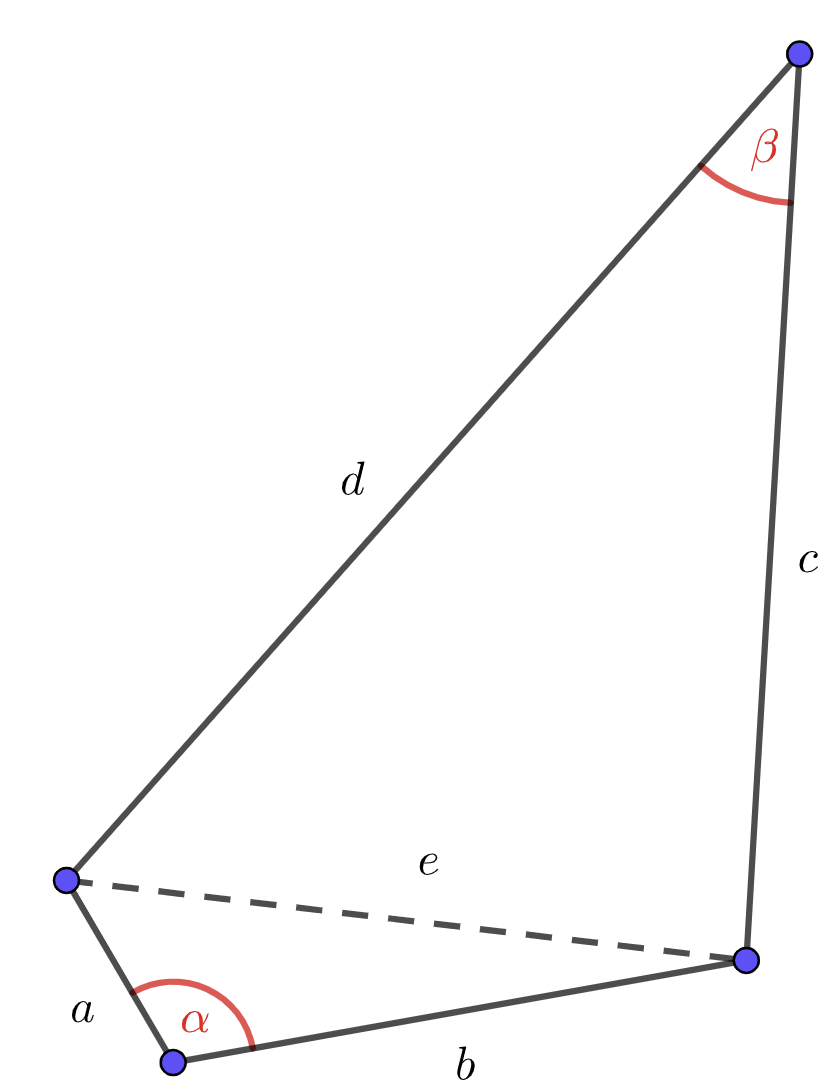I argue that the expression for infimum is more complicated and cannot be given by a single formula unless certain inequalities involving $a,b,c,d$ are assumed.
Let us work in the setting that OP considered for infimum: $a<b<c<d$. Denote the angle between edges of lengths $a,b$ by $\alpha$ and the one between edges of lengths $c,d$ by $\beta$. They are related only by the following constraint (which comes from considering the diagonal length $e$ in the picture):
$$a^2+b^2-2ab\cos\alpha=c^2+d^2-2cd\cos\beta.$$
Thus the goal is to obtain the optima of the area function $f(\alpha,\beta)=\frac{1}{2}ab\sin\alpha+\frac{1}{2}cd\sin\beta$ subject to the constraint $g(\alpha,\beta)=(a^2+b^2-2ab\cos\alpha)-(c^2+d^2-2cd\cos\beta)=0$. Using Lagrange multipliers, let us consider the points where $\nabla f=\left(\frac{1}{2}ab\cos\alpha,\frac{1}{2}cd\cos\beta\right)$ is a multiple of $\nabla g=(2ab\sin\alpha,-2cd\sin\beta)$. This amounts to $\tan\alpha=-\tan\beta$, i.e. $\alpha+\beta=\pi$. This is the case of maximum area mentioned in other answers. Therefore, to derive the infimum of $f(\alpha,\beta)$ given $g(\alpha,\beta)=0$, we should consider boundary values for $\beta$. The assumptions $d>a$ and $c>b$ imply $\beta\leq\pi$. Thus $\beta$ belongs to $[0,\pi]$. The boundary values for $\beta$ are thus uniquely determined by those of $\cos\beta$. Based on the constraint, the latter yield $\cos\alpha$ and hence two opposite choices for $\sin\alpha$. Substituting the negative one (which amounts to $\alpha>\pi$ and hence a concave quadrilateral) in the area formula yields a candidate for the minimum. In view of this discussion, let's analyze the extreme values that $\cos\beta$ takes.
Solving the equation above for $\cos\beta$, the fraction $\frac{c^2+d^2-a^2-b^2+2ab\cos\alpha}{2cd}$ must be between $-1$ and $1$. Conversely, any such fraction in $[-1,1]$ determines $\beta$ uniquely. The range for $\cos\beta=\frac{c^2+d^2-a^2-b^2+2ab\cos\alpha}{2cd}$ is
$$\left[\max\left(\frac{c^2+d^2-a^2-b^2-2ab}{2cd},-1\right), \min\left(\frac{c^2+d^2-a^2-b^2+2ab}{2cd},1\right)\right].$$
Notice that:
$\frac{c^2+d^2-a^2-b^2-2ab}{2cd}\geq -1\Leftrightarrow \require{enclose}\enclose{horizontalstrike}{d\geq a+b+c} \, c+d\geq a+b$ which always hold; and $\frac{c^2+d^2-a^2-b^2+2ab}{2cd}\geq 1\Leftrightarrow a+d\geq b+c$. So to simplify further, three two different regimes should be considered:
- $\require{enclose}\enclose{horizontalstrike}{d\geq a+b+c}$
(in which case the quadrilateral is concave unlike the picture above), - $b+c-a<d\leq a+b+c$ ($d\leq a+b+c$ must hold for a quadrilateral with side lengths $a,b,c,d$ to exist),
This pertains to the limit case that OP mentions: $\beta$ attains all values in $[0,\pi]$, and $\beta=0$ yields the minimum possible area as the area of a triangle with sides $a,b,d-c$. Thus minimum area is $$\sqrt{\frac{a+b+d-c}{2}\cdot\frac{a-b+d-c}{2}\cdot\frac{-a+b+d-c}{2}\cdot\frac{a+b-d+c}{2}}$$.
- $d\leq b+c-a$,
In this case, $\cos\beta$ attains all values in $\left[\frac{c^2+d^2-a^2-b^2-2ab}{2cd},\frac{c^2+d^2-a^2-b^2+2ab}{2cd}\right]$. In view of the constraint $a^2+b^2-2ab\cos\alpha=c^2+d^2-2cd\cos\beta$, the endpoints of the interval correspond to $\cos\alpha=\pm 1$. In these cases we are dealing with triangles of side lengths $c,d,a+b$ or $c,d,b-a$. Their areas are given by
$$\sqrt{\frac{a+b+c+d}{2}\cdot\frac{-a-b+c+d}{2}\cdot\frac{a+b-c+d}{2}\cdot\frac{a+b+c-d}{2}},$$ $$\sqrt{\frac{-a+b+c+d}{2}\cdot\frac{a-b+c+d}{2}\cdot\frac{-a+b-c+d}{2}\cdot\frac{-a+b+c-d}{2}}.$$ It is not immediately clear to me if one of them is always larger than the other.
Conclusion) When $a<b<c<d$, the minimum of area is achieved at one of degenerate cases where the angle $\beta$ between sides of lengths $c,d$ is $0$, or when the angle $\alpha$ between sides of lengths $a,b$ is $0$ or $\pi$. To see which of them happens and which of the resulting triangles yields the least possible area, further assumptions are required, e.g. if $a+d>b+c$ holds or not.
Note on the update) I corrected an error in the earlier version.

